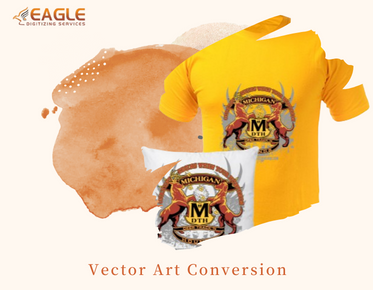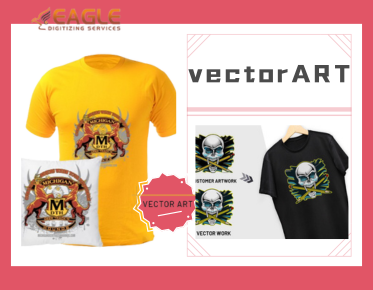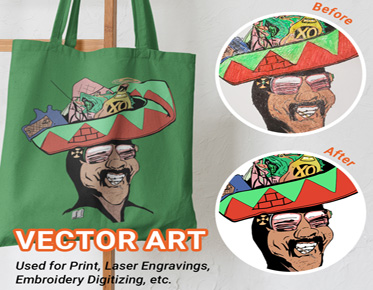The Digital Revolution: Transforming Graphic Design in Recent Years
The evolution of digital tools in the ever-changing world of graphic design has been nothing short of revolutionary. From the days of traditional handcrafted techniques to the advent of cutting-edge software and online platforms, the landscape of graphic design has undergone a profound transformation. This article delves into the impact of digital tools on graphic design workflows, exploring recent technological advances and their implications for the industry. If this post spurred your interest and you want to find out more about online vector conversion, please feel free to contact us.
Understanding
the Evolution of Graphic Design
Historical Context: Pre-digital
Era Design Processes
Graphic design has roots that trace back centuries, evolving from
manual techniques such as hand drawing, typesetting, and printmaking. These traditional
methods required meticulous craftsmanship and were often time-consuming and
labor-intensive.
Introduction of Digital Tools: A
Game-Changer for the Industry
The introduction of digital tools marked a paradigm shift in graphic
design, ushering in an era of unprecedented creativity, efficiency, and accessibility.
The transition from analog to digital processes revolutionized how designers
conceptualize, create, and communicate their ideas.
Significance of Recent
Technological Advances
Recent technological advances have further propelled the evolution of graphic design, empowering designers with powerful software, online platforms, and innovative tools. These advancements have democratized design, enabling individuals and businesses of all sizes to create professional-quality graphics with ease.
The
Impact of Digital Tools on Graphic Design Workflow
Streamlined Processes: From
Concept to Completion
Digital tools have streamlined the graphic design workflow, allowing
designers to seamlessly move from concept development to final execution.
Features such as layers, undo functions, and real-time previews enhance
productivity and enable iterative design processes.
Increased Efficiency: Time and
Resource Management
With digital tools, designers can work more efficiently, saving time
and resources compared to traditional methods. Tasks that once required manual
labor, such as color correction, image manipulation, and layout adjustments,
can now be accomplished with a few clicks.
Collaboration and Communication:
Breaking Down Barriers
Digital tools facilitate collaboration and communication among designers, clients, and stakeholders, regardless of geographic location. Cloud-based platforms, project management tools, and real-time sharing features enable seamless collaboration and feedback exchange, fostering greater creativity and teamwork.
Digital
Tools Transforming Design Creation
Vector Graphics Software: Adobe
Illustrator, CorelDRAW, and Beyond
Vector graphics software such as Adobe Illustrator and CorelDRAW
empower designers to create scalable, precise, and versatile graphics. These
tools are essential for logo design, illustration, typography, and other
graphic elements that require crisp lines and shapes.
Raster Graphics Software: Adobe
Photoshop, GIMP, and Affinity Photo
Raster graphics software like Adobe Photoshop, GIMP, and Affinity
Photo excel in photo editing, digital painting, and image manipulation. These
tools offer extensive editing capabilities, including layer-based editing,
non-destructive adjustments, and advanced filters and effects.
Layout and Publishing Software:
Adobe InDesign, QuarkXPress, and Scribus
Layout and publishing software such as Adobe InDesign, QuarkXPress, and Scribus enable designers to create professional-quality layouts for print and digital media. These tools offer precise typographic controls, page layout features, and preflighting capabilities for print production.
Advancements
in Digital Drawing and Illustration
Introduction of Graphics Tablets
and Pen Displays
Graphics tablets and pen displays provide a digital canvas for artists
and designers to create hand-drawn illustrations with precision and control.
Pressure sensitivity, tilt recognition, and customizable shortcut keys enhance
the drawing experience and facilitate natural and expressive strokes.
2D and 3D Software Integration:
Adobe Fresco, Procreate, and Blender
Integration of 2D and 3D software tools such as Adobe Fresco,
Procreate, and Blender blurs the boundaries between traditional and digital art
forms. Artists can seamlessly transition between 2D sketching and 3D modeling,
exploring new dimensions of creativity and expression.
Digital Brushes and Effects:
Mimicking Traditional Media Techniques
Digital brushes and effects emulate traditional media techniques, allowing artists to achieve realistic and textured results in their digital artwork. Brush dynamics, texture overlays, and blending modes replicate the tactile qualities of paint, ink, charcoal, and other traditional mediums.
The
Rise of Online Design Platforms and Marketplaces
Accessibility: Design Anywhere,
Anytime
Online design platforms and marketplaces democratize design by
providing accessible tools and resources to a global audience. Designers can
create, collaborate, and share their work from anywhere with an internet
connection, removing geographical barriers to creativity.
Templates and Assets: Enhancing
Creativity and Productivity
Pre-made templates and design assets streamline the design process,
saving time and effort for designers. From website templates and social media
graphics to stock photos and icons, these resources provide a foundation for
creative projects and inspire new ideas.
Community and Feedback: Engaging
with a Global Network
Online design communities foster collaboration, inspiration, and feedback exchange among designers worldwide. Forums, social media groups, and online portfolios create opportunities for networking, skill development, and peer recognition, enriching the creative journey for designers of all levels.
Responsive
Design and Adaptive Layouts
Designing for Multiple Devices
and Screen Sizes
Responsive design principles ensure that graphic assets adapt
seamlessly to various devices and screen sizes, including desktops, laptops,
tablets, and smartphones. Flexible layouts, fluid grids, and media queries
enable designers to create cohesive and user-friendly experiences across
devices.
Fluid Grid Systems and Flexible
Layouts
Fluid grid systems and flexible layouts provide a foundation for
responsive design, allowing content to reflow and adjust based on viewport
dimensions. Percentage-based widths, max-width properties, and breakpoints
optimize layouts for different screen resolutions and aspect ratios.
Media Queries and Breakpoints:
Ensuring Consistency Across Platforms
Media queries and breakpoints enable designers to define rules for adjusting layout and styling based on device characteristics such as screen width, orientation, and pixel density. Targeted styling adjustments ensure a consistent and optimized user experience across devices and platforms.
Automation
and Artificial Intelligence in Graphic Design
Machine Learning Algorithms:
Streamlining Repetitive Tasks
Machine learning algorithms automate repetitive design tasks such as
image cropping, color correction, and object removal, saving designers time and
effort. Smart algorithms analyze patterns and data to generate personalized
recommendations and optimize design workflows.
Generative Design: Exploring New
Creative Possibilities
Generative design algorithms generate complex patterns, shapes, and
compositions based on predefined parameters and rules. These algorithms
encourage experimentation and exploration, inspiring designers to push the
boundaries of creativity and discover novel design solutions.
AI-Powered Tools: Adobe Sensei,
Canva’s Smart Templates, and Beyond
AI-powered tools such as Adobe Sensei and Canva’s Smart Templates leverage artificial intelligence to assist designers in various aspects of the design process. From intelligent layout suggestions to automated image tagging, these tools augment creativity and productivity while reducing manual labor.
Augmented
Reality and Immersive Experiences
Integrating Graphics into
Augmented Reality Environments
Augmented reality (AR) technology overlays digital graphics onto the
real world, creating immersive and interactive experiences. AR applications
enable designers to integrate virtual elements into physical spaces, bridging
the gap between digital and physical realms.
Interactive Design Elements:
Enhancing User Engagement
Interactive design elements such as clickable hotspots, animations,
and 3D models enrich user experiences and engage audiences in meaningful ways.
Interactive storytelling, gamification, and real-time feedback foster deeper
connections and drive user engagement and retention.
Potential Applications in
Marketing and Branding
Augmented reality has transformative potential in marketing and branding, offering innovative ways to showcase products, engage customers, and build brand loyalty. AR-enabled packaging, virtual try-on experiences, and interactive advertisements create memorable and immersive brand interactions.
The
Impact of Social Media on Graphic Design
Visual Content Creation for
Social Platforms
Social media platforms such as Instagram, Facebook, and Pinterest rely
heavily on visual content to attract and engage users. Graphic designers play a
crucial role in creating eye-catching graphics, videos, and animations that
resonate with audiences and drive social media engagement.
Influencer Marketing: Leveraging
Visual Identity
Influencer marketing relies on visual identity to communicate brand
messages and resonate with target audiences. Graphic designers collaborate with
influencers to create branded content that aligns with their personal style and
values, driving brand awareness and consumer trust.
Trends and Aesthetics: Rapid
Evolution in Digital Spaces
Social media platforms influence design trends and aesthetics, driving rapid evolution and innovation in digital spaces. From minimalist flat design to nostalgic retro aesthetics, trends spread quickly across social networks, shaping visual culture and consumer preferences.
Inclusivity
and Accessibility in Design
Designing for Diverse Audiences:
Considerations for Accessibility
Designers must consider the diverse needs of audiences when creating
graphics, ensuring inclusivity and accessibility for individuals with
disabilities. Designing with accessibility in mind involves considerations such
as color contrast, font legibility, and screen reader compatibility.
Tools and Features for Inclusive
Design: Color Contrast, Alt Text, and More
Digital tools and features support inclusive design practices by
providing accessibility options such as color contrast checkers, alt text
prompts, and keyboard navigation shortcuts. These features empower designers to
create graphics that are accessible to all users, regardless of their
abilities.
Ethical Considerations: Ensuring
Equitable Access to Information
Ethical considerations in design extend to ensuring equitable access to information for all individuals, regardless of socioeconomic status or geographic location. Designers have a responsibility to create graphics that are inclusive, culturally sensitive, and respectful of diverse perspectives and experiences.
Challenges
and Opportunities in Digital Graphic Design
Learning Curve: Keeping Up with
Rapidly Evolving Tools
The rapid pace of technological advancement presents a challenge for
designers in keeping up with new tools, techniques, and trends. Continuous
learning and skill development are essential for staying relevant and
competitive in the ever-changing landscape of digital graphic design.
Maintaining Creativity in a
Digital Environment
While digital tools offer unprecedented flexibility and efficiency,
they also pose a risk of homogenizing design aesthetics and stifling
creativity. Designers must actively seek inspiration from diverse sources,
experiment with new techniques, and push the boundaries of digital creativity
to maintain originality and innovation.
Balancing Automation with Human
Input
Automation and artificial intelligence offer significant opportunities for streamlining design workflows and improving efficiency. However, designers must strike a balance between automation and human input, ensuring that technology enhances, rather than replaces, their creative vision and expertise.
Future
Trends in Digital Graphic Design
Continued Integration of AI and
Automation
The integration of artificial intelligence and automation will
continue to reshape the landscape of digital graphic design, enabling designers
to work smarter and more efficiently. From predictive design suggestions to
automated layout generation, AI-powered tools will play an increasingly central
role in the design process.
Expansion of Augmented Reality
Design Applications
Augmented reality design applications will expand beyond marketing and
branding into areas such as education, entertainment, and healthcare. As AR technology
becomes more accessible and affordable, designers will explore new creative
possibilities for immersive storytelling and interactive experiences.
Sustainability and Eco-Friendly
Design Practices
Sustainability considerations will drive the adoption of eco-friendly design practices and materials in digital graphic design. From reducing digital waste to minimizing energy consumption and carbon emissions, designers will prioritize environmental responsibility in their creative processes and decision-making.
Ethical
Considerations in Digital Graphic Design
Intellectual Property Rights:
Respecting Original Work
Respecting intellectual property rights is essential in digital
graphic design, ensuring that creators receive recognition and compensation for
their work. Designers must adhere to copyright laws and licensing agreements
when using third-party assets and respect the rights of other creators.
Cultural Sensitivity: Avoiding
Stereotypes and Appropriation
Cultural sensitivity is paramount in digital graphic design,
particularly when creating visuals for diverse audiences and cultural contexts.
Designers must avoid perpetuating stereotypes, cultural appropriation, and
misrepresentation, and strive to create inclusive and respectful
representations of people and cultures.
Environmental Impact: Minimizing
Digital Waste
Minimizing digital waste is an ethical imperative for designers, given the environmental impact of digital technologies. Designers should optimize file sizes, use energy-efficient hardware and software, and prioritize digital distribution over physical printing to reduce their carbon footprint and ecological footprint.
Conclusion
In conclusion, digital tools have revolutionized graphic design in
recent years, transforming workflows, expanding creative possibilities, and
shaping the future of the industry. From streamlined processes and responsive
design to automation and augmented reality, the digital landscape offers
endless opportunities for innovation and expression. By embracing change,
staying informed, and prioritizing ethical considerations, designers can
navigate the evolving landscape of digital graphic design with confidence,
shaping the future of design through innovation and creativity. For those
seeking to enhance their design capabilities, Eagle Digitizing offers professional vector conversion services to ensure your
graphics are of the highest quality and versatility.



